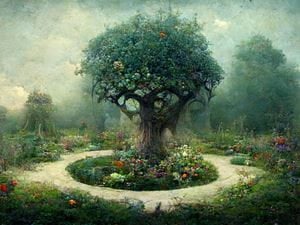
Where is the Garden of Eden? In the beginning, God made the heavens and earth. This, as we know, is the beginning verse in the Bible, which represents the beginning of all creation. In His wisdom and brilliance, God created this wonderful and brilliant world that we see. God also formed and shaped man from the ground’s dust and gave him dominion, as detailed in Genesis 1:26.
After creating man, the Bible says that God planted a garden in the east in Eden and put Adam into the garden He planted. Over the years, many have questioned what the Garden of Eden represents and where the Garden of Eden is located. Let’s delve deeper to understand the truth about the Garden of Eden.
What is the Garden of Eden?
The Garden of Eden represents something more profound than just a location. For starters, when you think about the term “Garden of Eden” in the original Hebrew language, you get Gan Eden, which means paradise or heaven. The garden represented a sinless paradise where Adam and Eve had perfect communion with God. Many scholars call it “Paradise Lost.” However, in understanding the Garden of Eden, you see God’s yearning for the life of every man or woman He created.
God created Adam and gave him a specific task. Adam’s job was to work the ground and keep it in order, as outlined in Genesis 2:15. In addition to fellowship with God, there was a reason for Adam’s existence, and the same is true of us. God created us for fellowship with Him but placed us here on earth because He has a specific assignment or task for us to accomplish. God let Adam eat from any tree in the garden, establishing a simple principle: it’s okay to enjoy the works of your hands or the fruits of your labor.
God had a specific assignment for Adam, but He also made provisions so he could complete it. Not only has God made us for a specific purpose, but He will give us provision so we can accomplish what He wants us to do. One of the benefits of doing God’s work is He lets us enjoy and share part of the work of our hands. The work wasn’t backbreaking, but Adam found pleasure in what he was doing. Remember, the world was sinless, so nature responded in a perfect environment. He found pleasure in his fellowship with God, and Adam also found pleasure in doing what God wanted him to do. It’s the same with us.
We will find pleasure when we finish the job God has created us for. The Garden of Eden or Paradise Lost can give us a picture of what our eternal destiny in heaven will look like. In eternity, we’ll continue to have a purpose, and we’ll experience God’s provision, having the perfect pleasure of God’s presence unimpeded by sin.
Where was the Garden of Eden located?
If you’re wondering where the Garden of Eden is, you’re not alone because many will search for the answer to this question. The biggest clue to help find this answer may be in Genesis 2:10-14, which says that a river watering the garden streamed from Eden. From there, it was broken into four headwaters. The first was Pishon, which winds through Havilah, where there’s gold. The second was Gihon, which goes through Cush. The third river was the Tigris, which runs along the east side of Ashur. Lastly, there was the Euphrates.
Scholars and scientists alike have used this information to attempt to determine the exact location of the Garden of Eden. Many have tried to say that due to the mention of Cush (modern-day Ethiopia) and the Tigris and Euphrates rivers, the Garden of Eden was located between Ethiopia and the fertile crescent in the Middle East. Sadly, what we’ll find is that many come to the conclusion that no one truly knows. The Institute for Creation Research wrote a compelling article about this topic, stating that one of the main reasons why we’re unable to pinpoint an exact location is the changes in the world that occurred after the flood.
It’s highly likely and quite possible that the flood changed the earth’s makeup, which could’ve affected the location of the Euphrates and the Tigris, meaning they might be in different locations than they were before the flood. This change has made it challenging for historians, scholars, and archaeologists to know exactly where the Garden of Eden is. While it’s possible to speculate, the truth is we’ll likely never know for sure.
Was the Garden of Eden real?
We understand it’s mentioned in the Bible, but because it can’t be found, some might question if it truly existed. Frankly, there are plenty who will call the Garden of Eden’s story a mythological lore. Still, part of the issue with this idea is that God was specific in not planting a garden but in doing it in a specific named location. The garden was planted in Eden, so not being able to find where the Garden of Eden is located doesn’t mean it doesn’t exist. Furthermore, the prophets referenced the Garden of Eden in Isaiah 51:3, Ezekiel 28:12-13, and Joel 2:3. What we also see is that Revelation 22:1-3 mentions a tree of life, which was located in the garden mentioned in Genesis.
Jesus also brought up the tree of life earlier in Revelation, specifically in Revelation 2:7. In fact, the tree of life that Adam wasn’t allowed to eat from once he sinned will be the tree of life we’ll be able to eat from in eternity. In the Septuagint, a Greek translation of the Old Testament, the word paradise is used in Genesis, the same word Jesus uses in Revelation. God also mentions it in the beginning, while Jesus mentions it at the end. This agreement is another reason to add to the Garden of Eden’s existence.
So, where is the Garden of Eden located? Frankly, no one has been able to pinpoint the specific location, though many have tried. However, what we do know is that Paradise Lost will become Paradise Regained. God’s plan for perfect communion and fellowship with those who love Him will be realized again, and this will last for all eternity.

